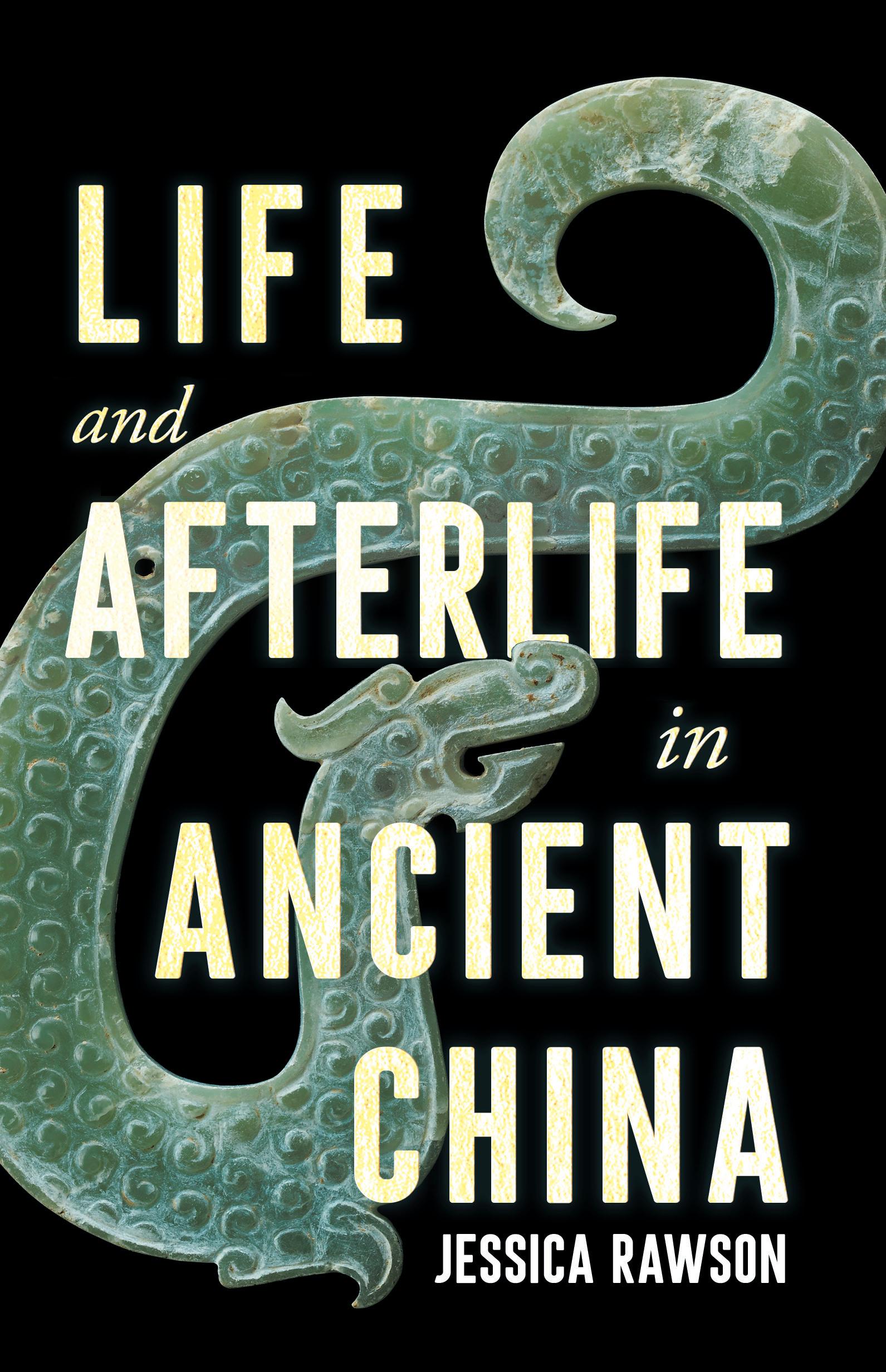
‘Enlightening and profound ... an underground journey to the heart of China’ Neil MacGregor


‘Enlightening and profound ... an underground journey to the heart of China’ Neil MacGregor
Jessica Rawson, Professor of Chinese Art and Archaeology and former Warden of Merton College, Oxford (1994–2010), was made Honorary Professor in the School of Archaeology and Museology at Peking University in 2019. For over twenty years before moving to Oxford, she worked in the Department of Oriental Antiquities (now the Asia Department) at the British Museum, as Keeper from 1987 to 1994. In 2005–06, she led the group of curators of the China: The Three Emperors, 1662–1795 exhibition at the Royal Academy, bringing to London magnificent works of art from the Palace Museum in Beijing. For more than forty years, she has visited, researched and lectured in most of China’s provinces, including at archaeological sites on both sides of its borders with Mongolia and South Siberia.
Jessica Rawson
UK | USA | Canada | Ireland | Australia India | New Zealand | South Africa
Penguin Books is part of the Penguin Random House group of companies whose addresses can be found at global.penguinrandomhouse.com.
Penguin Random House UK , One Embassy Gardens, 8 Viaduct Gardens, London SW 11 7BW
penguin.co.uk
First published by Allen Lane 2023
Published with a new Conclusion in Penguin Books 2025 001
Copyright © Jessica Rawson, 2023, 2025
No part of this book may be used or reproduced in any manner for the purpose of training artificial intelligence technologies or systems. In accordance with Article 4(3) of the DSM Directive 2019/790, Penguin Random House expressly reserves this work from the text and data mining exception.
The moral right of the author has been asserted
Typeset by Jouve (UK), Milton Keynes
Printed and bound in Great Britain by Clays Ltd, Elcograf S.p.A.
A CIP catalogue record for this book is available from the British Library
The authorized representative in the EEA is Penguin Random House Ireland, Morrison Chambers, 32 Nassau Street, Dublin D 02 YH 68
isbn : 978–0–141–99451–2
Penguin Random House is committed to a sustainable future for our business, our readers and our planet. This book is made from Forest Stewardship Council® certified paper.
1. China and Eurasia xvi–xvii
China and its provinces
3. Liangzhu and the Yangtze delta
4. Taosi and the Loess Plateau
5. Anyang and the western edge of the Central Plains
6. Sanxingdui and the Sichuan basin
7. Baoji and the Western Wei Valley
8. Liangdaicun and the meeting of the Yellow, the Fen and the Wei Rivers
9. Yuhuangmiao and the Yan Mountains
11. The Zeng and the Chu states
12. Lingshou and the Kingdom of Zhongshan
13. Majiayuan and the western edge of the Qin state
14. Xianyang and Xi’an
Before the unification by the First Emperor in the third century BC , the territory we now know as China was not a single state. In fact, the word China was not used in the West before the expansion of European trade from the late Middle Ages onwards. The Chinese term Zhongguo, meaning Central or Middle Kingdom, derives from the name used in the Warring States period (475–221 BC ) to distinguish the central states from those on the periphery. For simplicity, I will use China throughout the book, although we will not visit every corner of the present-day People’s Republic. We will focus on the area that stretches from the Great Wall to the East and South China Seas, and westwards to the edge of the Tibetan Plateau. The history of China is not just the history of the central states and is informed by three major and distinct regions. First, the middle and lower Yellow River, and its tributary the Wei, were the heartlands of the Shang and Zhou dynasties (c.1500–256 BC ). The Central Plains, the low-lying agricultural land east of the city of Sanmenxia, is used as a general term for this whole region, although it includes many areas, such as the North China Plain. I will call the mountains and valleys north and west of the Central Plains the Loess Plateau, although technically the name only applies to one part of a vast loess-covered landscape. This second region was and is an essential bridge between the agricultural valleys and plains and the steppe stretching from Inner Mongolia to the Black Sea and present-day Ukraine. The Yangtze basins, the foundation of China’s prosperity, with their humid climate and rich rice fields, form the third region.
The development of China’s civilisation – a mixture of social, cultural and environmental conditions – diverges from Western standards of social complexity. I have therefore recognised the distinctive, yet separate, features of China’s early cities and states. In the millennia
Author’s Note
before a writing system was developed, China was occupied by many different regional groups. They are traditionally named as cultures of a region, for want of a better way of describing who those occupants were. The word dynasty is widely used for the major ruling houses of China from the Shang (c.1500–1045 BC ) down to the Qing (1644–1911 AD ). The territories held by these dynasties varied significantly, as did the nature of their governments. The rule of the Shang and the early Zhou into the eighth century BC was not large and involved a network of relations with elite lineage leaders, that is, the families belonging to a single patrilineal line of descent from a known individual, often within a larger kin-related group here called a clan. Some were relatives of the kings; others were powerful local landowners from different clans. Their territories will be called polities. The boundaries of territories were not marked nor stable and could (and did) move from one place to another. From the mid-eighth century BC , when the military power of the Zhou kings declined, numerous contending polities were gradually amalgamated into larger holdings, here called states. Their systems of government have been slowly revealed by a combination of transmitted and excavated texts. The peoples within such states are generally given the name of the state. Thus, for example, the state of Chu can be referred to as Chu, and its people as the Chu.
In among Shang, Zhou and non-Zhou clans and states were groups of people named in bronze inscriptions and later transmitted texts as Rong, Di, Yi and sometimes Hu, living primarily along the north and east of settlements. In due course, some people joined the Chinese ritual and material cultures; others did not and retained their northern customs. The terms northerner, newcomer and outsider are used for those whose presence we can identify by their tombs, communities who did not adopt the principal cultural norms propagated by the central dynasties and whose names we cannot know.
Efforts have been made to limit the use of Chinese names used for places, individuals, titles, practices, tombs and their objects. Current transliteration, named pinyin, has been used. Where other forms were employed, as in some quotations, the pinyin alternative has been substituted. For the Notes, as many references as possible in
x
Author’s Note
English have been chosen. In all cases it is necessary to be aware that in China, with its different cultural foundations, some words inevitably have misleading meanings. For example, Western associations with the terms generally translated as state, king, temple, palace or even sacrifice do not necessarily reflect the practices of ancient China. Chinese place names, usually polysyllabic, are referenced on the maps. Personal names are often monosyllabic. Traditionally the family name – usually a single syllable – comes before the given name. This form is used in the Notes unless the author is better known by an English form of their name when publishing outside China.
The tomb plans and objects are all based on drawings in archaeological reports. The originals have been redrawn for the purposes of this book, often to show the outer surface of the piece as a whole. Without the careful work of excavators, it would not have been possible to uncover the tombs in such detail.
‘It would be a good idea to sort out the jades in the storeroom.’
When this suggestion was made to me in the 1970s, I was a junior curator at the British Museum and had just finished a second undergraduate degree, this time in Chinese, at the School of Oriental and African Studies. I was given the keys to a room alongside the loading bay, with a mass of stones, the famous Chinese jades. I soon realised that their history was little understood and that there was a lot to sort out.
I am grateful that my family had already lit my enthusiasm for languages with unusual scripts, especially Chinese. Dame Kathleen Kenyon, who accepted me as I left school to join her excavation in Jerusalem as a site supervisor, took me as far east as I could go in the 1960s. And throughout three seasons she built my interest in archaeology.
But I owe so much to the British Museum, its curators, several directors, most especially Sir David Wilson, exhibition designers, conservators and security staff. Above all, I had exceptional opportunities to see and learn about the multiple material cultures of Eurasia, often through working on interdepartmental exhibitions, including 7,000 Years of Jewellery, Animals in Art and Chinese Ornament: The Lotus and the Dragon. A large project, cataloguing a major collection of bronze ritual vessels in the USA , overseen by Harvard University, gave me much-needed experience of China’s extensive literature on its past. And into this whirl of cultures, jades came again in the form of Sir Joseph Hotung, with his magnificent jade collection at his house in Hong Kong. Joe transformed my academic life. His generosity in agreeing to my suggestion that he might not only kindly support the renovation of the Chinese gallery but add in the other half for the Indian subcontinent changed not only the Asian Department but also the whole Museum.
There is no way to sort out, indeed even recognise, ancient jades without examining them closely and holding them in your hands. Joe
Acknowledgements
encouraged me to do this and so opened my eyes yet further. And as more excavations in China were undertaken and published, opportunities to travel to China expanded. During my years as Warden of Merton College (1994–2010) and later as a researcher in the School of Archaeology at Oxford, I made repeated visits to sites across much of the country. In this work, I enjoyed the enthusiasm for China of other colleagues in the School, most especially Chris Gosden and Mark Pollard. The openness and support of colleagues in the archaeological institutes and departments throughout China taught me everything I know today. Without this interaction with the excavators, scientists, curators and students, my understanding of ancient China would be much more limited. I am also indebted to the advice from colleagues during illuminating visits to sites and museums in the Russian Federation and Mongolia.
As China became better known, I profited, as did the University of Oxford, from the award of two major grants by the Leverhulme Trust. A first grant, for the Study of Contemporary China, was one of the major stimuli leading to the creation of the University’s China Centre. And then, the Trust supported my research on ‘China and Inner Asia, 1000–200 BC : Interactions that Changed China’. This was the foundation of my work on exchanges between the steppe and the central states by way of the Loess Plateau. I am very grateful for the visionary approach of the Trust. I have also benefited greatly over these years from students in the School of Archaeology, whose research and discoveries expanded what we know about key interactions across Eurasia. All their work has contributed to this book.
Although it is in the news every day, too few of us recognise the foundations of modern China. While Europeans inevitably look back to Greece and Rome and beyond to ancient Mesopotamia and Egypt, the Chinese are equally conscious of their long past and its contributions to their lives, their language and their values. I presented some of the ideas in the book at the University of Cambridge, where I was honoured to be elected as Slade Professor of Fine Art (2013–14) and must thank the Electors and the Fellows of St John’s College Cambridge, where I enjoyed a fellowship for the year. I am grateful to Peter Straus at RCW for
xiii
Acknowledgements
encouraging and shaping my proposal and to Stuart Proffitt at Allen Lane for accepting it. Two editors moulded my attempts to open up a world shielded from us by distance, time and language. Ben Sinyor suggested the focus on tombs and their contents; Alice Skinner held me to this and worked tirelessly to help me realise the full breadth of the book. I am grateful for their persistence and encouragement at every stage. Many others at Allen Lane have made significant contributions along the way: Elizabeth Brandon, Amelia Evans, Sandra Fuller, Matt Hutchinson, Shauna Lacy, Linden Lawson and Rebecca Lee.
Two others were indispensable. Dr Limin Huan worked with me over several years on the role of horses, and on the loess region and its tombs. Limin also drew the maps for the book and provided me with a constant supply of information as I wrote the chapters and built up its bibliography. However, without John, my husband, the book would only be a shadow, as there would have been no drawings. He took a strong line. He believed that a book about tombs and their objects had to have illustrations, so undertook all the drawings of artefacts and many of the tomb plans. Unfortunately, he did not live to see the book published, but his collaboration, visible in every chapter, is a memorial to his continuous understanding and unfailing support of my work throughout our married life, be it at the British Museum, at Oxford or in China.
As the book covers such a wide area and long time period, I have trespassed on the patience of many colleagues, who have been kind enough to share their knowledge and to read one or more chapters: Anthony Barbieri- Low, Roderick Campbell, Konstantin Chugunov, Nicola Di Cosmo, Yegor Grebnev, Robert Harrist, Martin Kern, Maria Khayutina, Maxim Korolkov, Jianjun Mei, Susan Naquin, Armin Selbitschka, Jenny So, Alain Thote, Raphael Wong, Frances Wood, Jay Xu and Yijie Zhuang. I am grateful for their comments and corrections. Other colleagues have been so generous as to allow me to make use of their translations of early texts. For this paperback edition, some changes have been made and a revised and longer conclusion has been added. I am very grateful for the dedication of the two translators for the edition in Chinese, Dr Beichen Chen and Dr Chen Li,
xiv
Acknowledgements in suggesting these alterations and additions. Further support for this work has been given by Professor Fei Deng and Dr Hsiaoyun Wu. I am also indebted to directors of archaeological institutes and museums and to archaeologists in China for providing me with some precious photographs and granting the publisher permission for their use.

Minusinsk
Lake Balkhash Arzhan Pazyryk
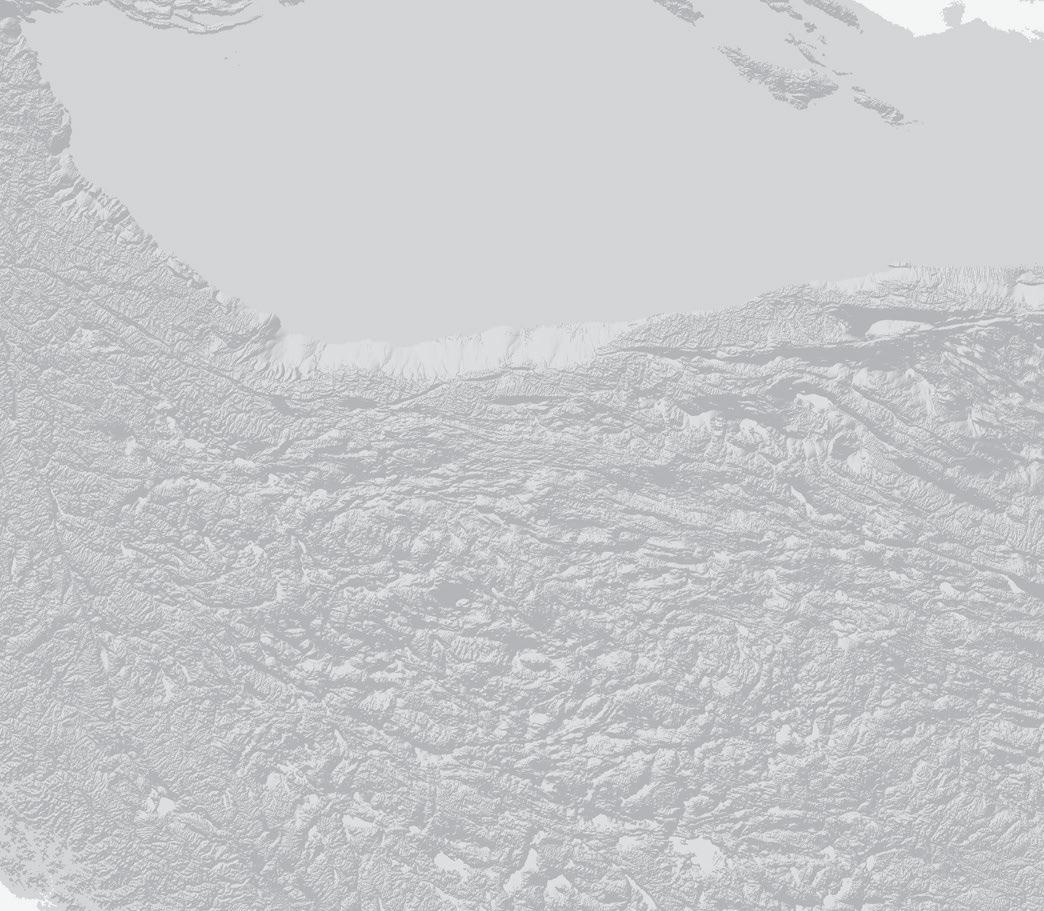

Tombs of Ancient China
Liangzhu
Taosi
Anyang
Sanxingdui
Baoji
Liangdaicun
Yuhuangmiao
Bengbu
Zeng
Xi’an 1. 2. 3. 4. 5. 6. 7. 8. 9. 10. 11. 12.
Lingshou
Majiayuan
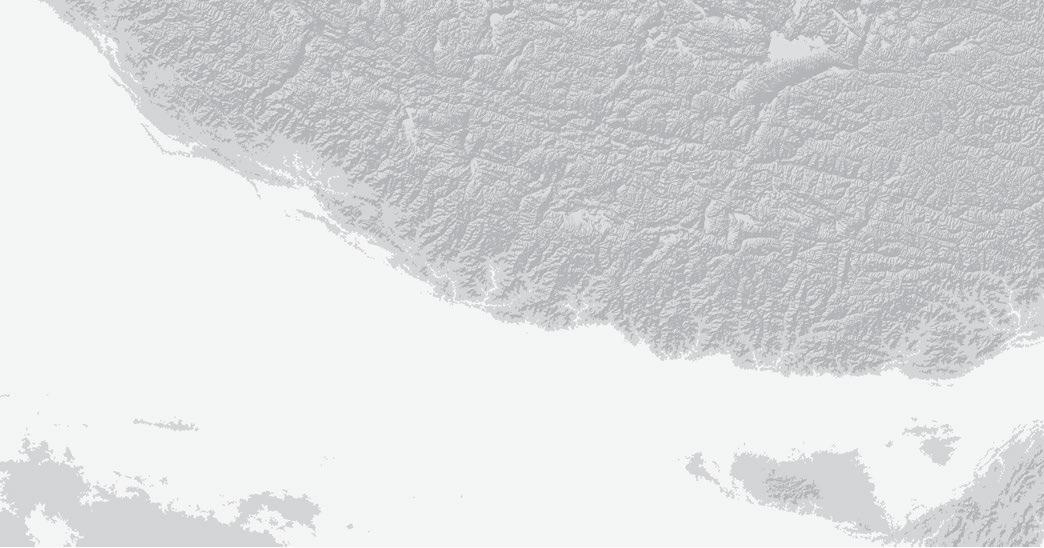
1. China and Eurasia
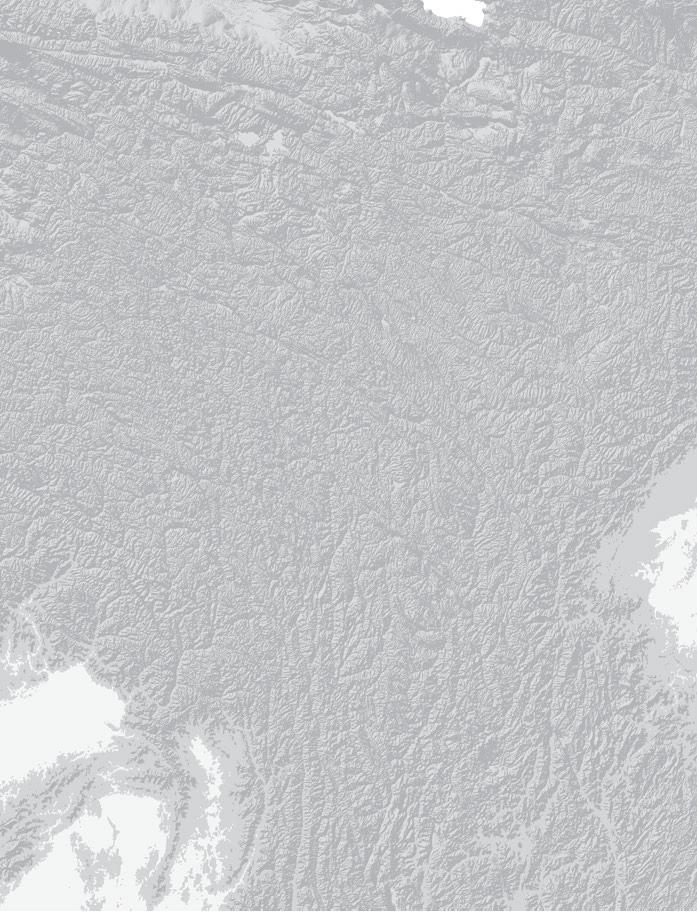







Wei River

Liangzhu Taosi
Anyang Sanxingdui
Baoji
Liangdaicun
Yuhuangmiao
Bengbu Zeng
Lingshou
Majiayuan

China and its provinces




China plays a leading political and economic role on the world stage but, beyond its borders, the country and its history are not well known. In part, this is because its formidable language, its people and its landscapes are unfamiliar. We in the West rarely possess Chinese cultural literacy: in fact, a British newspaper recently commented that there was ‘a severe national deficit’ in our understanding of China.1 A lack of empathy and even a perceived strangeness has obscured China’s long and distinguished past. If we fail to acknowledge and value its history, which still informs not only its present but all our presents, we restrict ourselves in our engagement with a country that spans five geographical time zones and borders fourteen nations. China’s modern leaders often refer to the 5,000 years of civilisation, built by distant ancestors, in order to underpin their country’s position and role in the international community. This epic timespan gives shape and meaning to the individual and collective identities of the Chinese, their ethical values and their aspirations, and deserves our recognition and consideration. Yet even 5,000 years underestimates the millennia over which China emerged, distinct from much of the rest of the Eurasian continent. The unprecedented scale and sophistication of objects and writings that survive offer the Chinese themselves an authority in a world of much younger states in Europe and the Americas. We can only look at a small fraction of these millennia. Nevertheless, the 3,000 years before the establishment of the imperial Qin dynasty in 221 BC – a time of early cities and the first dynasties – provide the foundation for many of the distinctive cultural elements that are still in place in China today. China embraces many extreme environments. Its territory stretches from the Black Dragon River, also known as the Amur, in the north,
Introduction: The World of the Afterlife which freezes in winter at minus 40 or 50 degrees, to the subtropical island of Hainan in the south more than 4,000 kilometres away. Europe – from the most northern tip of Norway to the southern coast of Spain – is about the same size. In three immense steps, the land of China descends west to east, from the great plateau of Tibet at c.5,000 metres high down to the loess of the north and the mountain ranges of the south at c.1,500 metres, and then finally into the lowlands of agricultural valleys and plains. A vast northern area, the Loess Plateau, is covered with loess, a fine, often semi-crystalline dust blown from the Altai Mountains, the Tibet Plateau and the Gobi Desert over thousands or even millions of years.2 This crucial land mass joins China to the grasslands of the steppe. In the centre and to the east, the middle and lower Yellow River flows over the plains on levees more than five metres high, and the Yangtze crashes south through the Three Gorges from the isolated Sichuan basin. This used to feed the great Yunmeng Marsh that, with the Dongting Lake, covered a basin near the city of Wuhan, now drained as farmland, long before it reached the sea at Shanghai.
A map alone cannot convey this challenging terrain, stretching not only beyond the horizon but beyond our imagination and experience. The only way to understand this extraordinary country is to travel through it. In the 1970s and 1980s train journeys took me and many others at a deliberate pace, past loess hills with cave houses carefully dug into them to the bamboo groves in the south. Today the pace has rocketed, and all who can take high-speed trains or fl y. China’s diversity disappears in such haste. We need to slow down to see the drastic changes in the landscape and histories of the territories that were unified by the First Emperor in the third century BC . These territories were more compact than present-day China. They spread from the eastern edges of the Tibetan Plateau to the northern deserts and steppe, from the East China Sea and to the banks of the Yangtze Valley, with even more remote lands further south, where Hong Kong stands beyond more rivers and mountains. Although there was continuous travel and connections by sea down the eastern coast, the sea played a comparatively
xx
Introduction: The World of the Afterlife
smaller role in ancient China than in the societies of the Mediterranean or the Indian Ocean.
Yet the ocean to the east does determine the climate of China and much of what we call East Asia. The Pacific Monsoon is a major flow of air that takes its moisture as summer rain. As these rains stall over the Loess Plateau and often do not reach the steppe, they set one of the most important boundaries in the world, a boundary beyond which crop-growing is possible, but limited. In the autumn the monsoon retreats, drawing the winds from the Arctic south over the steppe and much of northern China, spawning harsh winters. The monsoon is the source of China’s long-standing wealth. It feeds the Yellow and Yangtze Rivers and their tributaries, bringing humid summers so different from those around the Mediterranean. The gift of rain also fuels the farming of native grasses, domesticated as rice in the south and millet in the north. Rice – the most nutritious grain exploited around the world – is very labour-intensive, whereas millet has a remarkably short growing season, from seed to harvest in fortyfive days, and can thrive on higher ground. Both grains are boiled rather than ground to make bread, as in Western Asia and Europe, an Atlantic region characterised by dry summers and damp winters.3 This major variance in environment has led to two completely different lifestyles and cuisines.
China also diverges markedly from the West in its farming practices. Although mountain sheep and goats grazed on the ranges of the north-west, they were not present in the river valleys. The early peoples of these valleys instead domesticated dogs and pigs. The result was the growth of a population that did not have to compete with animals for land needed for pasture. From 3000 BC to the present, China’s huge population has been its central strength, enabling ambitious settlement projects and grand infrastructure, from the Great Wall, the Three Gorges Dam and the Forbidden City to high-speed railways, megacities and 5G internet. Early signs of ancient infrastructure lie in fragments of colossal buildings of rammed earth, city walls, dams and channels controlling the water necessary in the lands of the summer monsoon.4 Rammed earth was such an effective building
xxi
Introduction: The World of the Afterlife material that stone was not much used; indeed, it was often difficult to source. Bricks were not a major building material before the Han dynasty (206 BC –AD 220). So that, across China, we do not see many monuments equivalent to the stone temples of ancient Egypt, the high tells of Mesopotamia and Iran or the megaliths of Europe. The history of ancient China shows us that its peoples built their complex society in its own form.
As so much lies below ground, it has been easy to ignore the workforces operating in multiple groups within highly controlled enterprises.5 In due course, this adept subdivision of labour not only built cities, but created China’s renowned bronzes and terracotta warriors and spread across the world. We see traces of these exceptional creations in the white ceramics in thousands of canteens that imitate Chinese porcelains and the ceremonial dress of European courts made from Chinese silk. Materials were favoured in China that required a distinct combination of large- scale production and specialised skill: jade, silk, lacquer and ceramics. It was a major undertaking to mine jade, rear the grubs and harvest silk from thousands of cocoons, source lacquer sap from forests or procure and mix the best clays. Hundreds of accomplished artisans were then needed to work the jade, turn fragile lengths of silk into weavable thread, treat lacquer and knead clay, collect brushwood and fire kilns. These workforces both inherited manufacturing traditions and developed new techniques, requiring disciplined production lines. And in among these bands of artisans were individuals with the particular prowess needed to create unusual objects, such as the king-cong of Liangzhu, the coloured ceramics at Taosi or the bronze man from Sanxingdui. Objects were not simply luxuries but rather signatures of China’s culture, essential bonds between the living, their ancestors and the spirits in the millennia before c.1250 BC , when the first dynasties began to fully exploit writing.
Much of the early written history has come from the cities and rulers in the middle and lower Yellow River basin. Three dynasties – the Xia (possibly before 1500 BC ), the Shang (c.1500–1045 BC ) and the Zhou (c. 1045– c.750; then 750– 256 BC ) – dominate what became the
Introduction: The World of the Afterlife
central narratives of China. Working with earlier records, the famous Han dynasty (206 BC –AD 220) court archivist, Sima Qian, writing in c.100 BC , described these dynasties in the first extensive history of his world and shaped much of the later writing on them.6 Major ancient cities of the Shang and Zhou are recognised, but the settlements of the Xia have not so far been identified by archaeologists. The writings, ceramics and bronze vessels all drew attention to the Yellow River basin with a major capital at Anyang and the western capital city of the Zhou, near Xi’an. In the Spring and Autumn period (750–475 BC ), the population grew and incursions from the north threatened the local Zhou lords who controlled the agricultural areas in nearly 150 polities. This led to political and military confl ict, for which Confucius and other philosophers after him proposed resolutions. Increasingly deadly combat followed in the centuries of the Warring States (475–221 BC ), as larger states swallowed up the smaller polities, until the Qin were faced by six states – Zhao, Han, Yan, Wei, Qi and Chu – which they eventually conquered.
This vein of riches, and the eastern area called the Central Plains, divert our eyes away from two other regions, on either side of the middle and lower Yellow River, which were essential to the creation of an overarching empire. To the north, the highlands of the Loess Plateau (plate 5) stretch more than 1,000 kilometres from Lanzhou to the Taihang Mountains (plate 19), with further loess spreading north-east far beyond Beijing.7 The erosion of the Loess Plateau, with its cliffs and mounds – grey in colour but yellow in the light – gives the Yellow River its dense, opaque hue (plate 17). Rivers have spread this silt over basins and alluvial plains. Loess is an unusually stable geological phenomenon that enabled, even encouraged, people to dig spectacularly deep tombs, just as pozzolan – large accumulations of volcanic ash around and below Naples – was essential to set the concrete of Roman underwater harbour structures. The Loess Plateau was also at one and the same time both the edge of China’s agricultural wealth and an intermediary with the steppe, that great reservoir of people, horses and herds. Over the millennia described in this book, interconnected mobile populations built one of the world’s greatest routes of
Introduction: The World of the Afterlife communication, across thousands of kilometres of mountains and grasslands, long before the sea lanes opened up. Through the Hexi Corridor in the west, a string of routes across deserts and oases led to Central Asia. From 10,000 BC , no single ruler claimed or controlled the loess lands, and instead they nurtured many different clans and aspiring invaders, occasionally even stockbreeders from the steppe. This pivotal position between two contrasting ways of life made the people of the Loess Plateau perpetual contributors to the history and indeed the expansion of China’s material culture. The precariousness of their lifestyles contrasted with the agricultural prosperity further south, along the Yangtze, which supported several independent populations, who in turn built remarkably distinctive societies: we shall discover the jades in the Yangtze delta, bronze forests in the Sichuan basin, mounded tombs on the Huai River and writhing lacquer and bronze decoration south of the Han River. Before China was unified, and the Great Wall became its defensive line, the people of the Loess Plateau and the four basins of the Yangtze, while asserting their local customs, were slowly, step by step, drawn into the cultural practices of the Yellow River.
At first glance, China’s trajectory, from agricultural to urban states, resembles the histories with which we may be more familiar in Western Asia, Egypt and the Mediterranean, regions whose development is too often regarded as the benchmark for ‘progress’ across the world. However, we can see fundamental differences if we step through the mirror and take the grandeur of ancient China on its own terms. What we have often arbitrarily called ‘civilisation’ – namely settled livelihoods dependent on wheat and barley, domesticated sheep, goats and cattle, metallurgy and writing that spread, almost like a contagion, from Western Asia around the Mediterranean and northwards into Europe as people moved, traded and migrated – could not be taken directly east.8,9 Although these customs and skills did sometimes move south- east from Iran or Turkmenistan into the Indian subcontinent, vast mountains covered in thick jungle running south from eastern Tibet blocked further movement. The great height of
this Tibetan Plateau, about 2,500 kilometres from west to east, made it almost impossible for people and their animals from lower lands to adapt and make the arduous journey across its centre: they had to move along its margins (plate 4). This is the foundation of China’s independent civilisation. The summer growing season of rice and millet, the absence of herded animals, materials such as jade, lacquer and silk as status symbols before, and even after, metal was introduced via the steppe, and the relatively late creation of writing are all signs of China’s independence. Even the Three Ages, a widely accepted trope for historic development from stone to bronze and then to iron, did not occur or spread in China in a remotely comparable way, nor in fact in other continents such as the Americas and Australia. We therefore cannot expect China’s cities or early states to resemble those in Mesopotamia or ancient Egypt. Comparisons of diverse civilisations based on definitions, not just for cities and states, but also for rulership, rituals and beliefs, first identified for Western Asia, are misleading here when applied to regions beyond the Tibetan Plateau. The peoples in China took their architecture, their ambitions and their skills from their own environments.10
But China was never completely isolated. While straightforward routes across central Eurasia were barred for millennia by the height of the Plateau, contact, communication and encounter happened in other ways. The tectonic forces generated by the Indian subcontinent that drove up the Tibetan Plateau as it was thrust against Eurasia, elevated gigantic mountain ranges, forming the Hindu Kush in Afghanistan, the Pamirs, the Tianshan across Kazakhstan and China and the high mass of the Altai and the Sayan across north-western China, Mongolia and the Russian Federation (map 1). Mountains, reservoirs of minerals and water, were also important axes on the many paths of travel across Eurasia. The Altai-Sayan Mountains divide the western and the eastern steppe, and the tectonic movements give the eastern steppe additional height. These were the bridges around the Tibetan Plateau.
Geography is the single, outstanding reason why bronze was only widely taken up from the second millennium BC and iron from the
Introduction: The World of the Afterlife
eighth century BC (bearing in mind that the Hittites had iron weapons around 1400 BC ): these metals were first discovered in Western Asia and the Balkans and became the tools of peoples who, with their animals, materials and technologies, began to travel eastwards over thousands of kilometres and over hundreds, even thousands, of years. Long before these novelties reached China, the peoples of its river valleys had developed their own objects, traditions, social hierarchies and beliefs; metallurgy could only be adopted when it was accommodated into this universe. The immovable Tibetan Plateau ensured that the steppe, the Pamirs, the Tianshan and the Altai-Sayan became the main passages between two early settled worlds. The Belt and Road Initiative, the 7,000-kilometre gas pipeline from Turkmenistan to Shanghai and the Siberian gas pipeline from Russia to northern China, remind us that these routes still persist today.
The extraordinary creativity and diversity of ancient China lie in its great tombs filled with objects for daily and ceremonial life. In all parts of the world, tombs have survived more completely and over much longer periods than palaces, ritual spaces and ordinary dwellings. And with the tombs, in so far as they were not looted, have come highly valued treasures and everyday possessions. These possessions always tell us something, but we need to be alert and sensitive to the range of social and religious meanings they may carry.11 While the Egyptians built up, the Chinese built down. People on the dry Loess Plateau found that the geology of that region allowed the tombs to stand open as they dug seven, ten or more metres down without the shafts caving in. As the heights of the stone pyramids in ancient Egypt were symbols of power and realisations of belief in an afterlife, so in China the depth of tombs, and the installation of hoards of possessions, proclaimed the status of their owners and the future they expected to enjoy.12 In no other part of the ancient world was a plethora of such enormous and rich tombs possible across a large region, built repeatedly over millennia. Loess – rather than rocks and stone – was the foundation for these underground palaces, mansions or houses for the afterlife and it fostered the extravagant banqueting vessels, weapons and other objects which tell the stories of their
Introduction: The World of the Afterlife time. These tombs in the loess region and the valleys of the Yellow River, stimulated competition further south along the Yangtze and established a pattern that, unlike anywhere else, endured down to the nineteenth century.
To unearth China’s history and to visit its afterlife, this book will explore twelve burials (eleven tombs and one large sacrificial deposit), twelve colourful triumphs of engineering, each from a particular moment in history, from that of a leader in a city 5,000 years ago to the famous tomb of the First Emperor, Qin Shi Huangdi, who in the late third century BC built an empire to rival that of Alexander the Great.13 Most tombs were for men, but they were also granted to their spouses and concubines, making it possible for their inhabitants to continue to lead their lives fully and materially in the afterlife. These structures below the surface are the conspicuous celebration and vital extension of an individual’s life. They were and are their futures. Each tomb – its structure and its objects – tells us who they were, how they lived and what they owned, showing an individual at the height of their power and giving us a glimpse into their family’s aspirations for their afterlife, framed within an ever-changing and often exuberant social life.
The tombs are found in twelve different regions: from the wetlands of the Yangtze delta and the tributaries of the Yellow River to the arid landscape of the Loess Plateau and the mountains bordering the open spaces of the northern steppe. This book is not about death, nor are the tombs uncovered symbols of death. They are what they claim to be: dwellings for the afterlife. These immense dwellings are not symbolic, and in all centuries existed within a wider universe. The tombs show how, over millennia and across broad geographical and cultural regions, the ancient Chinese developed their own customs and beliefs, and then perpetuated them in the afterlife. Like a series of vivid scenes on a stage, the tombs are material evidence of life and reveal a wider history of how a diverse set of people became a relatively unified empire by c.221 BC. Although it has not been fully excavated, the tomb of the First Emperor, with the terracotta warriors arranged to defend him in his afterlife, is one of the most remarkable monuments in the world. Near Beijing are the later and more familiar
xxvii
Introduction: The World of the Afterlife imperial tombs of the emperors of the Ming (AD 1368–1644) and Qing (AD 1644–1911) dynasties, reflecting a tradition that goes back to long before there are surviving writings to explain what the ancient tomb occupants believed.
The history of ancient China will be told through the objects in the tombs. These objects allow us to enter a society, or societies, that can seem strange and are otherwise difficult to penetrate. Objects defined people’s personal and political relationships and, to an extent, the ideology and performance of ritual. We all subconsciously construe the material world around us. The functions of various pans in our kitchens, the dress of individuals we meet and the shining golden mosaics that bring Heaven into Christian churches are all based on a received set of ideas and assumptions, and on specific artistic and technical traditions. Meanings attached to everyday and sacred objects are found in all societies. But only those brought up in or educated by the society can easily read such objects. As children, we are in fact given a language of objects as well as a language of words. From our early years, we in the West use spoons and then learn how to pick up food with knives and forks. These utensils are often still alien to Chinese children, as are the foods we need to cut with them. It is only too easy for those of us from outside China to work within our own language of objects, which is as much a barrier as our inflected alphabetic language when we try to read the multitude of characters in written Chinese. All we can do, as Neil MacGregor reminds us, ‘when we venture in our own language into the thought worlds of others, is to acknowledge our inadequacy: we are discussing matters for which we do not have the words’.14 As with words, objects do not carry a single meaning. It is more helpful to think of motifs, images and materials as holding associations that are built upon functions, customs and beliefs, only truly understood through experience.15 As we move through the book, we will find that the tombs often hold inventories of weapons, ornaments and vessels belonging to not just one but to two or more languages. These reveal the multiple networks to which individuals belonged and the multiple identities they assumed and celebrated in their lives and afterlives. We have to develop a sensitivity
xxviii
Introduction: The World of the Afterlife and appreciation of these different languages, even if our interpretation can never be complete.
Many of the tombs are the consequence of binding religious and ritual practices, often summarily called ancestor worship. It is more appropriate, perhaps, to understand these practices as part of an ancestral cult, and this term will be used throughout the book. But even this fails to fully capture the full belief in the power of ancestors, and the ritual requirement to pay them respect by building deep tombs filled with a cornucopia of possessions and accompanied by regular nourishment through daily, weekly or annual rites. These are often named as sacrifices, but are not the kinds recorded in the Old Testament or Greek myths. They are in fact ceremonial banquets, offerings of lavish foods presented in multiple vessels of ceramic, bronze and lacquer, created with supremely sophisticated craftsmanship as some of China’s greatest works of art.16 This is a very different art form to the figural sculpture and painting that realised the Western Asian, Egyptian and Mediterranean religions. The beliefs to which these vessels belonged gave them an elusive quality that demanded the finest work in distinctive materials: ‘their ritual functions gave them power only when the vessels were made and used properly by proper persons for proper purposes at proper times in proper places and in proper ways’.17 Rituals were binding but not constraining, and should be seen as necessary but creative processes participated in willingly in the hope of a desired outcome. The ancestral cult developed and endured until the unification of China and continues in new ways today. It is a central component of China’s social architecture, running through families, villages and cities. The rituals and banquets for ancestors were carried out and performed within a family. That family might be extensive, including relations by marriage, but no one outside the family could join or would have wanted to join the rituals of another family, as we learn from brief mentions in a famous text known as The Zuo Tradition or Zuo Zhuan, dating to the fourth century BC or later, which presents a commentary on an earlier sequence of annals of the eastern state of Lu:
The spirits do not enjoy what is not of their kind, the people do not sacrifice to those who are not of their lineage.18
In modern China the cardinal importance of ancestors survives, as do the same limitations on those who can share in the rituals. It thus restricts the most important community to the family, which is the foundation of all beliefs, ethics and ritual practices. As rituals are not shared between other families or neighbours, they do not build the same mixed, inclusive communities that we see in Christianity and Buddhism on religious occasions.19 The privacy in which the ancestral cult is maintained has meant that the beliefs of most Chinese are little understood by those of us who live in countries that follow or are familiar with the culture, liturgies and public gatherings of socalled ‘revealed’ religions. Wall paintings and sculptures in Christian churches and Buddhist temples offer scenes of death and extinction. Chinese tombs do not. By contrast, they present and even create life. In any discussion of China, especially ancient China and its tombs, the ancestral cult – a religious belief with elaborate performance and veneration of the ancestors – is a central feature.
The private ancestral cult gave the family a powerful incentive to support and advance all its members. This was inevitable in any community where the welfare of the individual depended on their family. People turned to their ancestors for assistance against the sickness and misfortune that might come their way. Food was at the centre of the cult. There are no early writings before 1300 BC to explain these rituals. Ancient life and afterlife can only be discovered through material history, first in early tombs displaying vessels and then by examining inscriptions carved into bones for divination or cast into vessels in bronze. For later centuries, long bodies of writing set out how rituals for ancestors, spirits and ghosts should be followed. Tombs, filled with the objects of life, arose out of uninterrupted preoccupations with ensuring good outcomes for individuals and their families: wealth presented for the afterlife assured the ancestors of the success of their descendants.
This close bond between all members of a family, living and dead,
Introduction: The World of the Afterlife
had two other important long- lasting consequences. The first was that all forms of social hierarchy – in the family, in local organisations and in the state – were established by seniority, modelled on the sequences of the generations. Just as the seniority of the father above his son could not be defied, so all society was ordered in the same way. We also know from the earliest inscriptions that the same lineage structure was not only maintained, but forcibly proclaimed, by the first rulers, binding the state by the same principles as the family.20 Within such structures all women came below men, but were still important marriage partners. From 1200 BC to the present, this social framework has not been challenged or radically altered by any alternative religious or community structures. The coexistence of distinct communities founded upon religious, aristocratic and commercial groups did not emerge in China, unlike in medieval and Renaissance Europe, where the Church and monasteries, landowners, governments, merchants and craftsmen’s guilds jostled for power. 21 Even with the increasing popularity of deities such as the Queen Mother of the West from about the second century BC, or Guan Yu, a deified military leader of the third century AD , and the introduction of Buddhism after the fall of the Han, the ancestral cult and a hierarchical social structure remained ever present.22 In the fifth and fourth centuries BC , the natural powers, which had been recognised from at least the late Shang dynasty (c .1250 BC ) and were closely associated with divination, were also introduced into this ritual system. Later still the sun and the moon, heaven and the earth received offerings in ceremonial vessels at four altars that stand at the cardinal directions around the Forbidden City in Beijing. And while many tourists visit the Temple of Heaven today, they can hardly imagine, and never take part in, the grand annual court ceremonies that spread over the tiered marble platforms.
The China that grew upon these ancient foundations had room for many strong local traditions, which persist throughout our story. These did not displace the central practices of the ancestral cult and in fact many joined it, further emphasising the regional diversity embedded in China’s geography.23 As we examine tombs built over nearly
Introduction: The World of the Afterlife
3,000 years, we see the growing features of a universe that was generated not by gods and spirits but by existing forces of nature, which were part of, not outside, that universe. During the fourth century BC , these concepts matured and were reinforced by the binary forces of Yin and Yang, originally the terms for the shady and sunny sides of a mountain, that describe the processes of a constantly changing world, branching out in sets of fours and fives: Four Seasons, Four Directions, Five Colours, Five Sounds and Five Tastes. These correlations, which were entrenched in the Han dynasty, were also linked to ancient searches for positive outcomes. And this search maintained a concern with auspicious signs, leading to some of the most accurate records of eclipses, and later a panoply of images – the lotus, peony and the pine tree.24
The ancestral cult lay within a widely shared understanding of the universe, binding the living, those inhabiting the afterlife and future generations in a continuing story of belonging.25 The world of the living was overseen by ancestors, living in their tombs. Instead of a universe generated by God, as described by the Book of Genesis, or the pantheon of Greek and Roman deities ruling the heavens, the underworld and the ocean, the ancient Chinese universe was ordered by correlations and analogies, placing the powers of the ancestors in parallel with or above those of the living. Analogies have existed in other societies as ways to comprehend deities: for example, the power of God was represented by Him seated on a throne as a king in medieval Europe. And as we follow the gradual spread of the ancestral cult, we will also explore tombs expressing entirely different cosmologies through heterogeneous objects infl uenced by other cultural forces from the south and the world of the steppe.
Alongside the ancestral cult – interacting with diverse local customs – and a self-generating universe of correlations, a third essential element fostered continuity in ancient China: the remarkable script which we call Chinese characters.26 These were employed widely by the late Shang dynasty and are still in use today. Based originally on pictographic and diagrammatic forms, Chinese characters each signified a
Introduction: The World of the Afterlife
single spoken word and were developed for a spoken language. Over time, the characters came to be pronounced differently by speakers of different dialects, but their semantic meanings only changed slowly. Although people may not have understood each other’s speech, they could read and write the same characters, somewhat in the manner that speakers of English, French or Hindi understand written numbers – 1, 2, 3 – in the same way but pronounce them differently. The separation between meaning and pronunciation in Chinese, impossible in alphabetic languages, meant, for example, that edicts from the central government, despatched throughout the early empire of the Song dynasty in the tenth century AD , could be understood by all literate officials, irrespective of their local spoken dialect. Likewise, scholars, whatever their dialect, could read the same texts from earlier times. Apart from inscriptions on early bones used for divination and on bronze vessels used for ceremonial banquets, only a few surviving documents are contemporary with the individuals in the early chapters. The abundant transmitted writings, generally taken as the foundation of early history, were not usually from the same time as the events they described. They were compiled, sometimes centuries later, handed down and edited over hundreds of years. The objects in the tombs provide new ways to interpret the official written history of ancient China, often telling us about what was omitted or forgotten by these early documents.27
The tombs illuminate how three fundamental elements – the ancestral cult, a universe of correlations and analogies and a shared script – were taken north and south outside the middle and lower Yellow River basins. The Loess Plateau and the basins along the Yangtze originally fostered ways of life, cultures and beliefs very different from each other and from the dynastic rule of the Shang and the Zhou in central China. And even as peoples in these two regions adopted these practices and beliefs, they retained their local customs. Throughout, the Loess Plateau serves as an essential buffer zone between the pastoralists of the steppe and the farmers of the settled river basins. The mixed populations of agriculturalists, herders and, from c. 800 BC , stockbreeders who brought horses from the steppe, granted them
xxxiii
Introduction: The World of the Afterlife
considerable cultural infl uence and even political power. These northerners, as we shall see, did not follow the rituals of the ancestral cult. But they were important agents bringing new materials and technologies into central China. Over centuries, communities moving south with their horses to live alongside the states were only accepted if they too adopted the ancestral cult. We can identify those who did from the objects in their tombs, and thereby also those who remained outsiders.
The peoples of the Yangtze basins also had objects and beliefs unlike those of the Yellow River. There was communication but little direct movement by southerners into the centre. However, as the competition between the central states spread from the eighth century BC , many groups and clans from the south and east were attracted to and eventually did join the political power bases and religious framework of the central states. Their adoption of vessels for the offerings to ancestors and of written characters was significant, even while they retained many of their own traditions. Over the last thousand years described in this book, the lords of the Yellow River also expanded both north and south. Despite this growth of an official and organised state, the multitude of landfalls, steep mountains, piled swathes of loess and rich, but ever flat, plains encouraged a medley of cultures. In the tombs we meet a China replete with a bewildering diversity that is still familiar today. Their inhabitants contributed to the longterm development of one of the world’s greatest civilisations, and a world view that was formed as much by interactions across a multitude of environments and among local cultures as in the heartlands of the Central Plains.


Liangzhu and the Yangtze delta
If one material represents, even embodies the values and expectations of China, it is jade. This hard, almost translucent stone, cold but with a soft, silky touch, is the most treasured material throughout the whole of China’s history – from the jade peaches of the garden of the Queen Mother of the West and the wisdom of sages, often carved in jade among craggy mountains, to the auspiciousness of jade dragons, phoenixes and the bixie, a leaping creature that, with its one horn, can protect from ill. For all familiar with jade, it carries an unspoken quality of perpetuity, even immortality. For two millennia, from the time the Han armies moved into today’s Xinjiang province in the first century BC, jade has been unquestionably associated with the western mountains of the Kunlun, the northern edge of the Tibetan Plateau.1 This origin story was reinforced by anecdotes that were eventually recorded in the seventeenth-century encyclopaedia by Song Yingxing, The Exploitation of the Works of Nature (Tiangong Kaiwu ), on the manufacture of a range of materials, including woodwork, paper and ceramics. The passage on gems describes jade as being collected from the rivers that descend from the great heights of the Kunlun Mountains along the north of the Tibetan Plateau:
Crude jades [or jade-containing rocks] are not buried deeply under the earth, but instead are formed in places where precipitous mountain streams rush by. Because of the swiftness of the current, however, miners do not obtain jade from its original deposit. Rather, they wait until the streams are swollen in the summer, when the crude jades will be carried away by the current and can be gathered from the river, perhaps 100 or even 200 or 300 li from their original
head ornaments
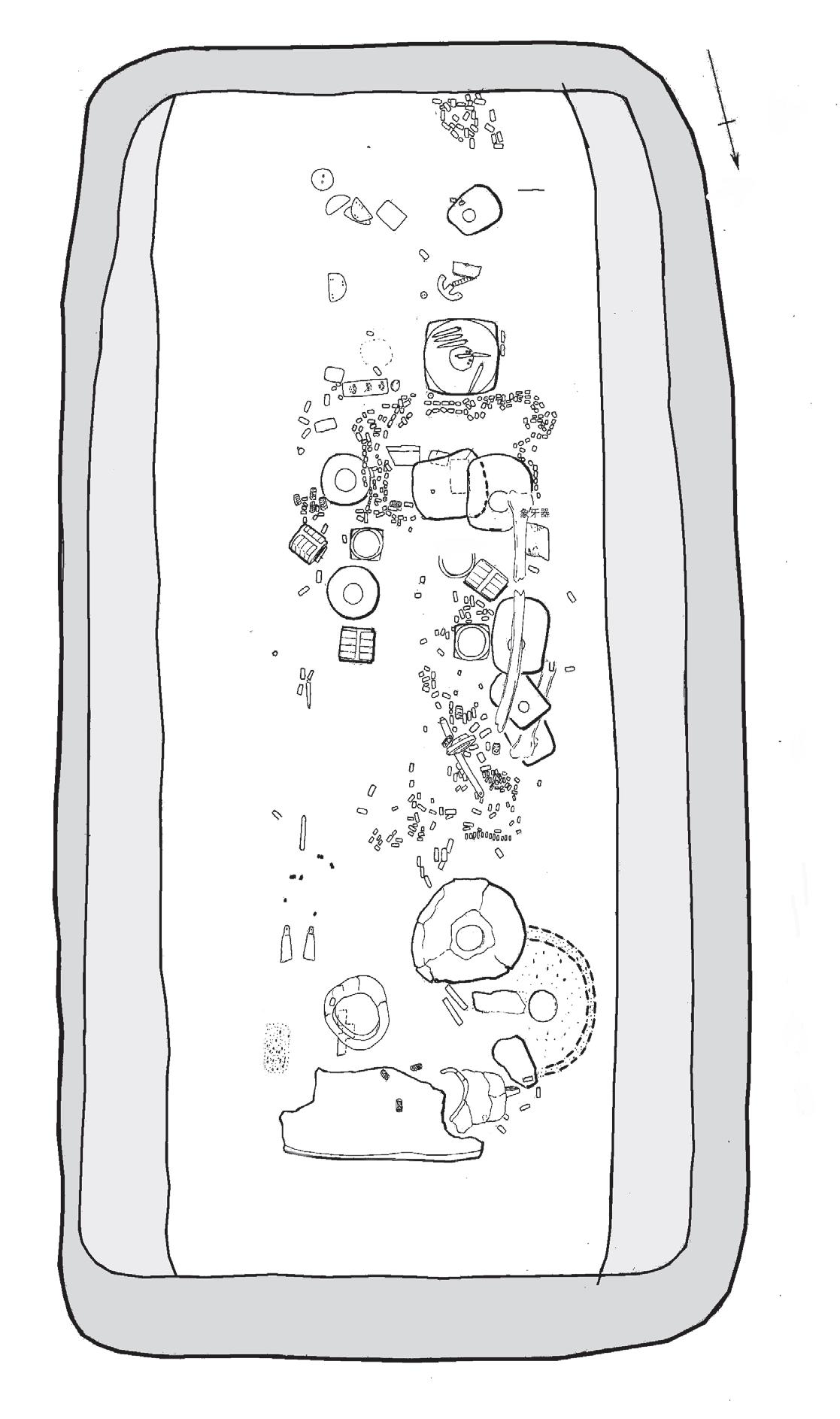
cong
cong
king cong beads
lacquer jug comb top channel ledge
The tomb at Fanshan, Liangzhu. Length 3.1 m, width 1.65 m, depth 1.1 m.
The Mystery of Jade deposits. Since jade is formed by the shining essence of moonlight, those who gather it along the river banks often keep watch there under the autumn moon. When an especially brilliant light is spied, there crude jades are sure to be found. After travelling together with the current [for a considerable distance], the jade-containing rocks are still mixed up with ordinary rocks in the shallow water and must be picked up, examined and identified.2
If this is the case, why turn to the small town of Liangzhu, near the great city of Hangzhou on the Qiantang River? Although some mountains embrace the scenery, these are not the great peaks of the Kunlun. Moreover, Liangzhu is on a huge delta, not where valuable rocks are usually discovered.
The Yangtze River is only surpassed in length by the Nile and the Amazon. It rises on the Tibetan Plateau and travels more than 6,000 kilometres to the sea at Shanghai. As the East China Sea rose and advanced inland at the end of the last Ice Age, some 15,000 years ago, the river laid deposits of silt at its mouth, creating a delta. Nanjing, for a time the capital of the Ming dynasty in the fourteenth century AD , stands on the southern bank. Other famous cities, most especially Suzhou, a jewel of exquisite gardens, lie near Lake Tai at the centre of this triangular spit of lowland the size of Wales.
The Yangtze delta is home to more than 140 million people in the densest concentration of towns, cities and megacities in the world. It is a region of great agricultural, industrial and international trade, extending south as far as Hangzhou, today a landmark for its prosperity and for being the home of the technological giant, Alibaba. The shimmering Lake Tai, the mists and the intense humidity are traces of a different and ancient world. The delta is the hinterland of one of China’s most outstanding ancient cities, named after Liangzhu. It dominated for over 1,000 years, from about 3300 to 2200 BC , and is set in a curved basin, with some higher land to the east protecting it from surges along the Qiantang River; the Tianmu range guards it to the north-west. Despite the growing infl uence of the industries at Hangzhou, Liangzhu is still remote. A bus is the only way to travel into the
Building and Dwelling, 3200–1200 BC early history of jades. In the late 1980s, fields of rice stretched over the whole basin. Now a town flourishes, a sign of China’s recent prosperity. The basin and all the land to the north was once covered by sea.3 After the sediment deposits from the Yangtze and Qiantang, much was covered in brackish water. In due course it became a freshwater marsh. As the waters retreated in the fourth millennium BC , people began to make a living here. Predecessors of the Liangzhu people, named by archaeologists as the Songze, gradually moved south across the whole region from c.4000 BC onwards.4
To celebrate Liangzhu, an archaeological park – freshly planted with trees – was opened in 2019. If we are to understand how jade came to dominate Chinese culture, we need to follow the intriguing discs, tubes and beads that have cropped up in the area since 1936 – signs of a city where jade had been at the centre of the lives, the deaths and the beliefs of its leaders. The first major tombs were discovered in the 1980s, but it was still hard to envisage a vast city as no buildings have survived above ground. Everything that remains is below the surface of mounds covered in vegetation. The immense walls of the city and numerous water channels were first fully excavated in 2006– 7;5 only then did scholars begin to recognise the remarkable traces of a whole vanished society, supported by rice agriculture.6 In China walls are a sign of urbanism; in fact the Chinese character for wall is also used for a city. Liangzhu not only had huge walls, but was the central settlement across the delta. We do not know who lived there, nor how the population was organised, but the success of the society can be measured in the scale of its water management, which marks the landscape, its huge harvests of rice and its sophisticated jades. These were not the achievements of a series of small villages. Liangzhu must have been the seat of power, a great city, even if it does not resemble the ancient cities of Mesopotamia. More has been discovered since 2013, as archaeologists moved into the mountains and across the flood-plains.7 These campaigns revolutionised our understanding of the history of ancient China, and that of the wider world. In 2019, the water management around Liangzhu, as well as the city itself, became a World Heritage Site.8
Along with the archaeological park, an intensely angular museum offers an introduction to this underground city. It is a series of low, brilliantly white blocks of windowless galleries. Designed by the British architect David Chipperfield, it is faced entirely with travertine stone from Iran. The strength of the stone is awe-inspiring. The entrance is through a long glass façade. Inside, a wide atrium is open to the sky. Great white discs, with central holes, appear to float like waterlilies on a dark pool, echoing ancient jades. On display are similar discs, much smaller of course, and axes so smooth and beautifully curved they hardly look like weapons. And most strange of all are jades of varying heights, square in section with a central, circular hollow column, a kind of tube, with traces of eyes at their corners. Eyes appear again on a rectangular plaque from one of several cemeteries at Liangzhu; it rises to a central point along the upper edge with two outward-sloping sides and has three holes along the bottom to attach another part of what was an ancient comb.9 Its creamy surface is marked with sloping bands and is wonderfully soft to the touch. These dark grey-green bands almost hide the engraving cut into the surface. Jades were clearly more than trinkets to the people who lived at Liangzhu until c.2200 BC . And two pairs of eyes, small round circles near the top and extended ovals with circular pupils lower down, are on many Liangzhu jades, as are the two bird-like creatures in the corners. But what is jade?
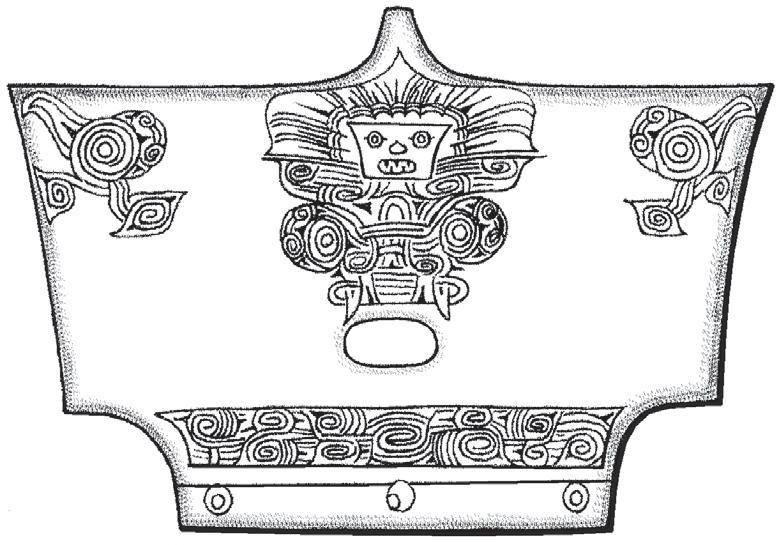
The head of a jade comb, just 5.8 cm high and 7.7 cm wide.
Building and Dwelling, 3200–1200
The answer is not at all obvious. In English, the term jade is used for a variety of green, grey, white or darkly clouded minerals, of which the most significant is nephrite. Others include forms of serpentine, and another stone called bowenite. Similarly, in Chinese a single word, yu, is used for several minerals. Rarity is the hallmark of jade. For the Chinese the most highly prized yu is also nephrite, and the majority of the Liangzhu jades are of this mineral. 10 Nephrite can be found in many cloudy colours, from pure white to a green so dark that it is almost black. Regardless of colour, nephrite is exceptionally difficult to work: because it is formed under great pressure and heat over ancient geological time, its tiny, needle-shaped crystals become interlocked and matted. This means it does not fracture into its crystals as, for example, diamonds or emeralds do, nor can it be cut by metal. As early inhabitants of Liangzhu explored the nearby mountains and made contact with the world around them, they probably found a good source of jade. We do not know its location – an essential part of why the discovery of so many jades on a delta remains a mystery.
Nephrite is usually mined from seams often fractured among other minerals and rocks. Someone must have discovered rocks with translucent veins and attempted to extract them, which is not an easy task. First, nephrite had to be removed from the surrounding rock with stone tools (the only ones available), although some rocks may have been split with heat to extract the jade. Then bigger sections were cut into smaller slabs and chunks; it had to be ground with a brittle sand, such as corundum, applied with a tool, such as bamboo, in which the corundum can easily be embedded.11 This combination creates an ancient form of what we recognise today as sandpaper.12 Finished jade feels smooth to the touch because it has been repeatedly polished: a seductive, tactile quality that has always attracted owners to wear small ornaments against their skin. While jade is hard and cold, silk is soft and warm. The feeling of both is almost impossible to describe, yet inherent to the value of many objects in China. The same silkiness is found in lacquer, in Song-period ceramics, whose grey-green glazes reproduce jade, and even in later Ming furniture. One result of
The Mystery of Jade
cutting blocks of jade in this way was constant flat surfaces that could be modified and polished. When cutting the stone into pieces, many offcuts were inevitable, which could then be skilfully shaped to make objects such as the comb head we have just seen, and small decorative pieces and beads. We do not know how the fine lines depicting the eyes of a man and the strange creature were incised into this hard mineral; small fragments of a silica, rather like fl int (widely distributed across Europe), may have been used.13 Liangzhu must have had unusually plentiful sources, as there was enough nephrite to create broad axes, discs and numerous tubes.
Nephrite does not disintegrate and disappear over time. When buried, traces of chemicals in the surrounding soils and humidity sometimes turn it a chalky white, but it often does not change much at all. Permanence is one of its defining qualities. The scarcity of nephrite ensured that, once it had been worked, only the highest-ranking members in early societies could own it. Its rarity raises a profound question. How did it become so embedded in Chinese culture, so widely accepted as part of its social and ritual landscape? Jade and the many ancient shapes into which it was worked here at Liangzhu are completely unfamiliar to everyone outside China. Even when we hold a piece of jade, the many threads woven into its history lie far outside our grasp. It is our first meeting with a material and its forms that belong to an unknown cultural language.
In fact, even for Chinese scholars, the low-lying, waterlogged area around Liangzhu looked like the last place where such an abundance of ancient jades would be found. Throughout written history, from at least about 1000 BC , jade had been mentioned in inscriptions on bronze ritual vessels and in transmitted documents. People acquired ancient jades and made many copies, not knowing anything about Liangzhu. In the following centuries, especially after the fifth century BC , these antique pieces were given names. The huge discs copied in the atrium at the museum had traditionally been given the name of bi. The tube with a square cross-section and a central vertical hole was given the name cong. These names cannot have been used at Liangzhu; their owners would have had their own names, in their
Building and Dwelling, 3200–1200 BC
own language. As the people of this ancient city are not likely to have developed writing, we, tantalisingly, have no way to discover what these could have been. The terms bi and cong became standard in the Warring States period of the fifth to third centuries BC . 14 During a time of almost continuous confl ict, ritual specialists and scholars attempted to retrieve and to follow the ritual practices of their predecessors, the kings of the early Zhou dynasty (c.1045–750 BC ), regarding them as models of righteous, upright rule. Specialists strung together a list of names for jades and then added what they believed they signified. A summary of these, including the cong, was set out in a famous ritual text, the Rites of Zhou (Zhou Li ), collected and compiled in the third to second centuries BC :
Jade is used to make six ritual implements for ceremonies to Heaven, Earth, and the four directions.
The blue bi [disc] for offering rituals to Heaven,
The yellow cong [tube or cylinder] for offering rituals to the Earth,
The green gui [sceptre] for offering ritual to the East,
The red zhang [sceptre] for offering ritual to the South,
The white hu [tiger-shaped pendant] for offering to the West,
The black huang [arc-shaped pendant] for offering to the North.15
All of these (with the exception of the hu ) were much older than the Zhou dynasty. The cong probably predated the Zhou by 2,000 years. Before jades began to be excavated at Liangzhu, the origins of their shapes, given names by much later ritual specialists, were just not known. Associating jades with the Zhou dynasty gave them prestige in a culture that valued writing and its history, but this was totally misleading. Ancient jade forms, profoundly meaningful for those on the southern edge of the Yangtze delta, who built an enormous city surrounded by water channels and rivers, had been taken over and put into someone else’s story. This is a very human activity, and throughout history there is a persistent tendency to identify sources of, or attribute meanings to, objects. People in a completely different urban society living more than 2,000 years later in the middle
The Mystery of Jade and lower Yellow River basin – with different types of burial, possessions, aspirations and beliefs – could not have had any knowledge of Liangzhu. These Zhou societies had developed a universe of correlations, which over time became part of a later and much wider philosophical endeavour, formalised in the Han dynasty. And then this list was memorised and guided subsequent owners, scholars and jade traders. Attributes of the universe were organised into tables, with the opposing forces of Yin and Yang, the Five Phases of wood, fire, earth, metal and water, and the Five Directions – North, East, South, West and Centre – connected with the five colours of black, green, red, white and yellow. For example, Yang signified brightness, heat, dryness, hardness, activity, masculinity, Heaven, sun, south, roundness and odd numbers, and Yin darkness, cold, wetness, softness, quiescence, completeness, femininity, Earth, moon and north, squareness and even numbers. The square section of the cong appeared, misleadingly, to offer a way to understand the world as square beneath the bi, the circular heaven above.16 The cong and other jade forms of the Liangzhu people had been reappropriated and become embedded in a different society. This transformation has added to the mystery of jade. Even though we are now able to recognise two unconnected systems of belief, it remains difficult to truly appreciate what we are looking at. The roles of the jades have become blurred, and it is very hard to bring their original meanings back into focus.
Discoveries at Liangzhu took ancient China’s jades back further by several millennia to long before the Zhou, and indeed to before the rise of dynasties in the Yellow River basin. The jades showed that the area between the Yangtze River and Hangzhou housed a particular group of people with skills in working jade and beliefs associated with this precious stone. The real turning point was an excavation in 1986, when a cemetery of eleven tombs at Fanshan was revealed in the Liangzhu basin.17
One of the most interesting tombs is over three metres in length, about one metre in depth and has two channels along its length on either side of the central section. These are sometimes identified as
Building and Dwelling, 3200–1200 BC
the foot of a wooden chamber, within which was a smaller coffin. More distinct traces of wood have been found at other sites of the same period. Given the acidity of the soil, very little remains of the skeleton of the male occupant. Clothes or items made of textile or other organic materials, which may have been with him, have not survived either. Looking down into the tomb, we can see that jades and stone axes were spread over the length, obviously to cover his body. He must have had an intense preoccupation with jade in death – 647 jades are listed in the excavation report. They were clearly of very high value and will lead us further into jade’s history. Although elegant ceramics have been found at many other Liangzhu sites, there were only four in this tomb at Fanshan, alongside a red lacquer jug inlaid with small jade fragments. The red colour was derived from the mineral cinnabar. A long loop of jade beads would have encircled his neck or shoulders; others hung much lower down. Above the man’s head were several finely carved jade plaques, a form of insignia attached to a hat or a band worn around his head. Positioned where his chest would have been was a jade axe, with several stone axes on his left side. A massive, square block of jade, of the type named today as a cong, was near his left shoulder. So remarkable is the size of this piece and its multiple engravings that it is sometimes called the ‘king-cong ’. Numerous miniature jades – plaques, long spiky pendants, beads and ornaments that could be strung together – were also the signatures of a powerful man. A different set of ornaments are thought to have been for a woman. We know nothing about the relative status of women at Liangzhu. But if some of the tombs were for them, then they too had a high standing. Buried with such a striking display in jade, the man and his peers at Fanshan were certainly among the leaders of the city.
The man’s jades are in three categories: tools and weapons, such as axes; objects of personal adornment attached to his clothes or hung around his body, which displayed and reaffirmed his identity; and cong tubes, which like bi discs served no obvious function, but almost certainly were of ritual significance. 18 The jade axe is the centrepiece. It is of great elegance and beauty, not made to cut down
Mystery

The jade axe, length 17.9 cm, width 14.4 cm, engraved with a man and beast.
Jade a tree or to behead an enemy. Its sheen and careful finishing are for a weapon of might, not of war. For a jade it is substantial, with a curved cutting edge and swelling surfaces on the two sides showing off the efforts of sophisticated craftsmen with extensive experience in the jade tradition. At Liangzhu, on easily flooded land, which required the management of great populations to build its huge walls, this axe must have served as an emblem of authority. A small hole near one edge allowed it to be tied to a wooden staff that carried attractive jade ornaments top and bottom. On both sides, in the upper corner, is another sign of the axe’s power. A sharply angular face with tiny circles for eyes peers out of an enigmatic, almost human figure. A narrow mouth shows clenched teeth. The small face is overwhelmed by a feather headdress, rising to a point at the centre. The other face below, also in relief, has two oval eyes with circular pupils, surrounded by a dense sunken pattern which covers the bridge above the nose. This combination of relief and sunken design suggests that the two beings are emerging from within the jade itself. In the lower corner, on both sides, one eye of the monster has been turned into a bird.19 We do not know who or what these entangled figures and the two pairs of eyes, one for a human figure and one for a more animalistic monster, portray. But the intensity of their stare and their repetition on many jades underline the fundamental role that they played in the Liangzhu universe.20

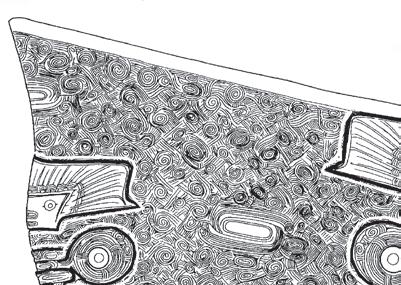
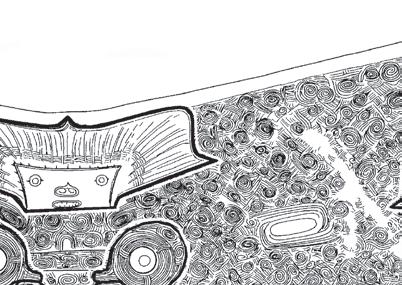


The engravings on the sides of a jade fitting for a staff, drawn and presented together, height 5.72 cm, length 8.4 cm.
The edges repeat the embroilment of the man and beast.
The eyes appear again on a band wrapped around a small, semirectangular jade. Their force is yet more intense. This piece of jade, less than six centimetres in height, has a slot on the underside and, like the axe, may have been fitted to a wooden staff. It is covered in spirals and criss- crossing bundles of lines. Every inch is filled with movement. On the two outer edges are the man with his headdress and the fanged monster with its bent legs and claws. The engraved figures had to be stretched around the wide edges and were transformed by the curved surface. The dense lines surrounding the two figures suggest that they are hidden beings who only appear occasionally. Perhaps these are mists of another realm, or the clouds of visions and dreams. What this fantastical creation signified we do not know, but its decoration is the measure of its effectiveness in joining its owner with a mythical past or the powerful spirits of the universe, a bridge to an unseen world. This is the only example of such a piece found to date. The owner must have been celebrated for possessing so special an object. That it could only be seen from up close further emphasises its value.
Small ornaments attached to a person define their age, gender and role in society. People across the world have used metal crowns for leaders, chains and medals for office, rings for marriage and necklaces and brooches to signify wealth or endow status. In the West such ornaments are usually in shining gold or silver, decorated with
The Mystery of Jade sparkling cut gems. In China the tone and style of jade ornaments are completely other. The many thousands of years for which it has been mined and carefully worked have given jade a supreme status. Such was the continuity that during the Ming dynasty men wore belts with jade plaques and carried, as sceptres, tablets based on the shapes of ancient jades, and women wore jade flowers in their hair.21 If we are to appreciate the power of the man buried at Fanshan with his magnificent cong, we must look next at what is known of the remains of the ancient city; the world in which he lived.
Liangzhu is one of the very largest early walled settlements, that is, a city, in ancient China. With its inner area of three square kilometres and an outer one of some eight square kilometres, the excavators of Liangzhu have compared its estimated population size with Uruk in southern Mesopotamia (c.3300 BC ) and Harappa in the Indus Valley (c.2500–1900 BC ).22 Yet it is not its size that awards Liangzhu its prime place in the history of China, but the achievements of its people in managing their landscape and their creation of a distinctive identity and cosmology. When evaluating early cities, historians have often turned to those in Mesopotamia and Egypt, where wheat and barley fed populations. Until recently, the lives and the sophistication of societies built upon rice-farming have been little considered. Domestication of this native grain was probably achieved between 6000 and 5000 BC . 23 And rice cultivation was at the heart of Liangzhu’s success. It would have been difficult to create a settled life in south-eastern China without rice. The low-lying lands brought wealth but also hazardous sea surges and flooding rivers.
Remains of flooded rice fields fed by channels of water from rivers and ponds have been found outside the centre of Liangzhu, at Maoshan.24 Complex irrigation systems, which must have needed constant manipulation and repair, render rice one of the most labourintensive of all domesticated grains regulated by the seasons.25 From May to June the Pacific Monsoon sweeps across the whole of southern China, which remains humid throughout July and August. Rice must be sown, and the sprouting seedlings planted as the rains arrive.
Building and Dwelling, 3200–1200 BC
Winter meant fewer farming demands, so people turned to building the irrigation channels needed to provide water and drainage. In this tough environment, large- scale infrastructure would have taken a long time to develop. Every stage required many groups to fetch almost unfathomable quantities of earth to create channels and dams. And as control of the water was essential to rice-farming, its management required careful planning.
This was a world in which small bands of people were coordinated to realise an important project. Today, as visitors walk along the planked paths over marshy land and numerous small tributaries, it is no surprise to learn that Liangzhu had canals inside and outside its walls – fifty-one small canals within the ancient city and eight water gates. Remains of wooden posts suggesting docks for boats and traces of what may have been canoes and paddles have also been discovered.26 Walls of rammed earth with foundations of rocks, sometimes as wide as 120 metres, enclosed the central area. Controlling the water in and around the city was not enough. Before the city reached its present form, levees and dams had been constructed across much of the basin. This is an indelible imprint of human activity, and also a clear sign of the skill of the leaders at Liangzhu in managing giant projects.
Sections of the enormous line of banks and levees can still be identified at the foot of the Tianmu Mountains. They protected the city from precipitous flows of water coming off the steep slopes at the height of the monsoon. Before they used their labour force to build city walls, the leaders at Liangzhu deployed their population to build not just the lower levees, but also additional defences deeper in the mountains. Several high dams held back canals, restricting the flow of water down on to lower land. It has been estimated that perhaps 3,000 people worked for over eight years to set up the system.27 It may have taken much longer, and there were probably earlier attempts. The dams were made of ancient sandbags of local mud wrapped in reeds and grasses. These have intrigued archaeologists as they show a highly advanced understanding of engineering: the dams – between 20 and 50 metres in length and up to 7 metres in height – were not experimental. Many smaller dams had been made before the more ambitious
The Mystery of Jade constructions. After all, if they failed, they would catastrophically flood the land below.28 Lower- level dams held back lakes of freshwater for agriculture. As small sea surges forced brackish water into the channels that were vital to the management of rice fields, back-up sources of good rain and river water were valued by the community. We know that the organisation of water for the rice fields produced huge quantities to feed the population. A great store of charred rice, weighing more than 13,000 kilos, was found at the centre of the city, probably from granaries destroyed by fire.29 There were no rice fields within the city or nearby. Instead, this supply was commanded by leaders able to demand and extract rice from more distant agricultural lands.
Liangzhu certainly grew over the 1,000 years of its existence. Its population inevitably had to create higher areas on which to live. Mounds were found around the city, and people may have occupied them and parts of the walls.30 Detailed surveys and excavations have brought to light additional areas fenced with sandbags.31 The sandbags and rice fields demanded a continuous input of human labour to shift the earth and transform the landscape. Other contemporary cities in various regions across the Yellow River basin, at Taosi in the north and in present-day Shandong province, must also have relied on subdivided labour forces to build rammed-earth walls and platforms.32 Liangzhu is one of the original examples of the Chinese architectural tradition of wide earthen platforms supporting lighter wooden columned buildings. We still see this today in the Forbidden City. There, the earthen platforms are hidden by elaborate stone facings. This decoration makes us immediately realise how much we have lost of ancient Chinese cities. Not only are we missing the wood and bamboo that formed the structures of the halls and houses; their roofs of rush and reeds are also gone, and we can no longer see the texture and carving of building decorations. What we have is telling. But it must always remind us of what has vanished.
Mojiaoshan, a platform of between 10 and 15 metres in height on a small hill at the centre of Liangzhu, must have supported buildings with wooden columns. Excavators estimate that some 2,280,000
Building and Dwelling, 3200–1200 BC cubic metres of earth were moved to create it and compare it with the transfer of the 2,500,000 cubic metres of stone to build the Khufu Pyramid in Egypt some 300 years later in c.2500 BC . 33 The rectangular area, 630 by 450 metres (about 74 acres), held further platform foundations, possibly for palaces, ritual temples or administrative centres. Mojiaoshan is indicative of the centralised leadership of this great city. The Fanshan cemetery, on its own platform, is just north-west of Mojiaoshan. When we reflect upon the achievements of Liangzhu, we see that the people buried at Fanshan must have been crucial to those efforts, being laid to rest at the centre of the city and at an elevation that corresponded to their commanding position at the top of society – a position also expressed by the jades they took with them to the afterlife.
But the size and infrastructure of Liangzhu do not totally explain the presence of extraordinary jades. High levels of organisation and skilful management of water would not have necessarily led to the working of fine jades with mysterious faces. Nor can jade production have happened all at once.34 Very few societies have made use of jade – other notable examples include the Olmec and the Maya in Central America and the Maori in New Zealand, but none on the scale nor with the antiquity we find in China. By the time that the man was buried at Fanshan, jade had been known for at least 4,000 years. For jade to have been widely used, the sources of the material, the ways of working it and, most importantly, the notion that these stones were desirable had to have developed and spread. This was not a single idea, invented in a single place.
While there is no direct source of its spiritual qualities, jade has a long history among multiple peoples along China’s eastern seaboard, from the far north near the Amur River down to the Yangtze delta and on further south. Joined by the sea and many waterways, extensive lines of communication had been developed. The translucent stones were venerated by people living during the last Ice Age, the Late Palaeolithic (30,000–10,000 BC ), who also used mammoth ivory and animal teeth for ornaments.35 These materials were scattered across forests and tundra and along immense frozen rivers in today’s Siberia,
The Mystery of Jade bordering Heilongjiang province. The earliest nephrite in the territory of present-day China has been found at an ancient burial ground just south of the Amur, in a cemetery of small stone mounds holding jade ornaments, dating from approximately 7200–6200 BC . 36 We do not know the histories of these people but we have a much fuller picture of how jade was taken up further south, in the areas north-east of Beijing in Inner Mongolia and Liaoning from the seventh millennium BC . Here too jade appeared as personal ornaments, especially for the ear, as slit rings. These, together with thin square plaques with rounded corners and a central hole, were very popular and repeatedly made and copied down the eastern seaboard among many small societies across a huge area. We find the peak of this second stage of jade-working in graves of the Hongshan culture, outlined with stones and embedded in spreading stone mounds, at a site called Niuheliang, built around 3500 BC . These turned a natural landscape of rolling hills into one filled with monuments for people with particular beliefs and rituals.37 The dead were given jades as they entered the afterlife.38 Here, as at Liangzhu, the presence of jade expressed beliefs in the powers of the material to join the worlds of the living and of the afterlife.
Among the several jades buried by the Hongshan people, a heavy coiled creature is the most important. It is often of a bright, translucent green stone (plate 22). This thick circle, about 10 centimetres high, with a horizontal slit across one side, is a magnified version of the earlier jade ear ornaments. The surfaces are smoothly curved, and above the slit is the face of a creature with prominent, rounded ears. Some see this as the head of a pig, the primary animal domesticated in ancient China after the dog. But below the ears are two wide eyes, one on either side of the ring. These staring eyes are a far cry from the intricacy of the Liangzhu faces. This is a parallel, but very different, choice of an unrecognisable creature, a being beyond daily life, whose form and material probably offered authority to their owners. To create it the jade craftsmen exploited a rare material which they could bring to life with a glowing surface.
Faces will appear again and again in our story. And we must never
Building and Dwelling, 3200–1200 BC
expect these faces to have borne the same meanings across time and place. Some objects were transported over long distances by exchange or picked up as chance finds by travellers; objects do not, and often cannot, take their original meanings with them. For that to happen their makers and owners have to travel too, and successfully communicate their beliefs. We in the West put Chinese vases decorated with bats on our tables and mantelpieces, but we do not know that, for the Chinese bats bring prosperity. Twisted pine trees, on the other hand, celebrate wisdom and endurance in old age. These porcelain motifs have travelled, but the significance they hold for those who made and owned them has not. Despite different meanings and styles of production, the Hongshan jades confirm that, in eastern China, as at Liangzhu, elites used jade to express their powers, and to be in close communion with the invisible.
Although the Hongshan people lived more than 500 years before Liangzhu grew to its full size, we find traces of contact over more than 3,000 kilometres along the eastern seaboard and by sea. The Songze, predecessors of Liangzhu in the Yangtze delta, produced jade carvings resembling turtle shells, a human figure with raised arms, and the coiled ‘pig dragon’, all of which had prototypes in Niuheliang.39 Bangles and rings may have travelled to the Songze. Some were damaged, some were recut. This abundance of jade over 1,000 years built what could be called a Jade Corridor.40 The Liangzhu people created jades echoing distant memories of the Hongshan dragon, with similar small coiled dragons with prominent eyes.41 The spread of rings and bangles drew these faces into the Liangzhu repertoire, but two major changes were made, in effect reinterpreting the creature. The heads were turned 90 degrees and framed within a rectangle. This was the first important step towards the monster faces on the cong. Workers had at the same time found that silica, or another stone, could cut into nephrite, and now made these ancient motifs using a new technique. This second step transformed the rounded lines on the Hongshan dragon into the dynamic figures engraved into Liangzhu jades. While the faces within the raised rectangles on rings or bangles retained the eyes, nose and mouth in relief, the jade workers
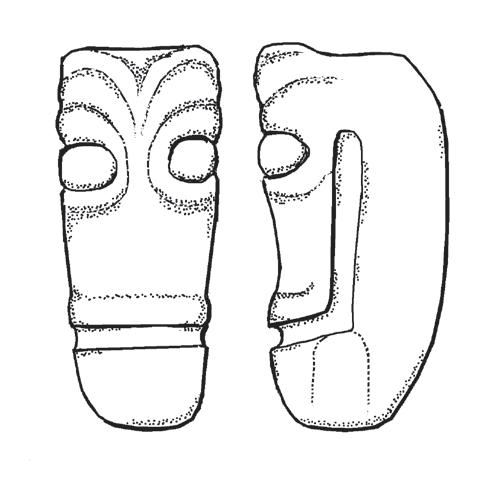
Mystery of Jade now incised numerous fine lines to provide a dense patterned background.42 The human-like figure was also added, with its arms and the bent clawed legs of the monster carved at a lower level into the surfaces. These features were a sign that the relief and the fl atter designs have different sources. The jade workers had thus brought into being an original motif with new meanings and purposes. As we follow those steps taken over many centuries, the transformation of
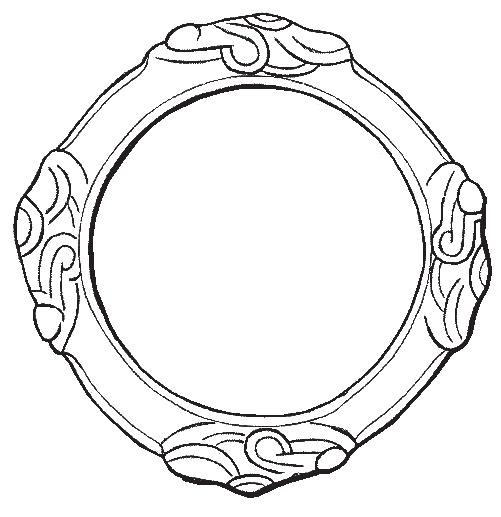
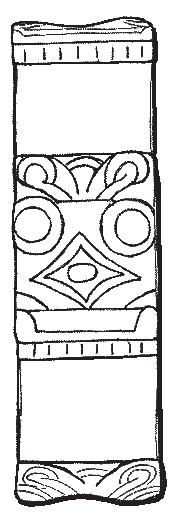

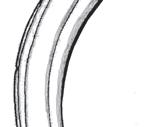

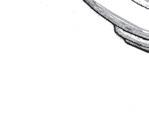
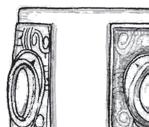
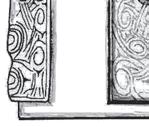
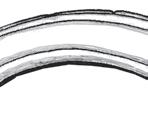


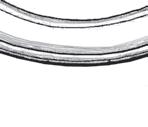

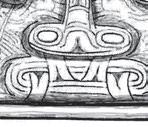
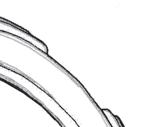
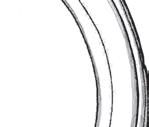
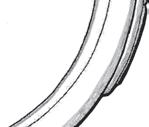
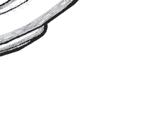
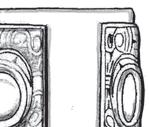

The bangle (top left), diameter 8.2 cm, is a development of the face of the coiled creature in plate 22. The faces have then been rotated and elaborated, highlighting a surge in craftsmanship, in the bangle (top right), diameter 7.95 cm.